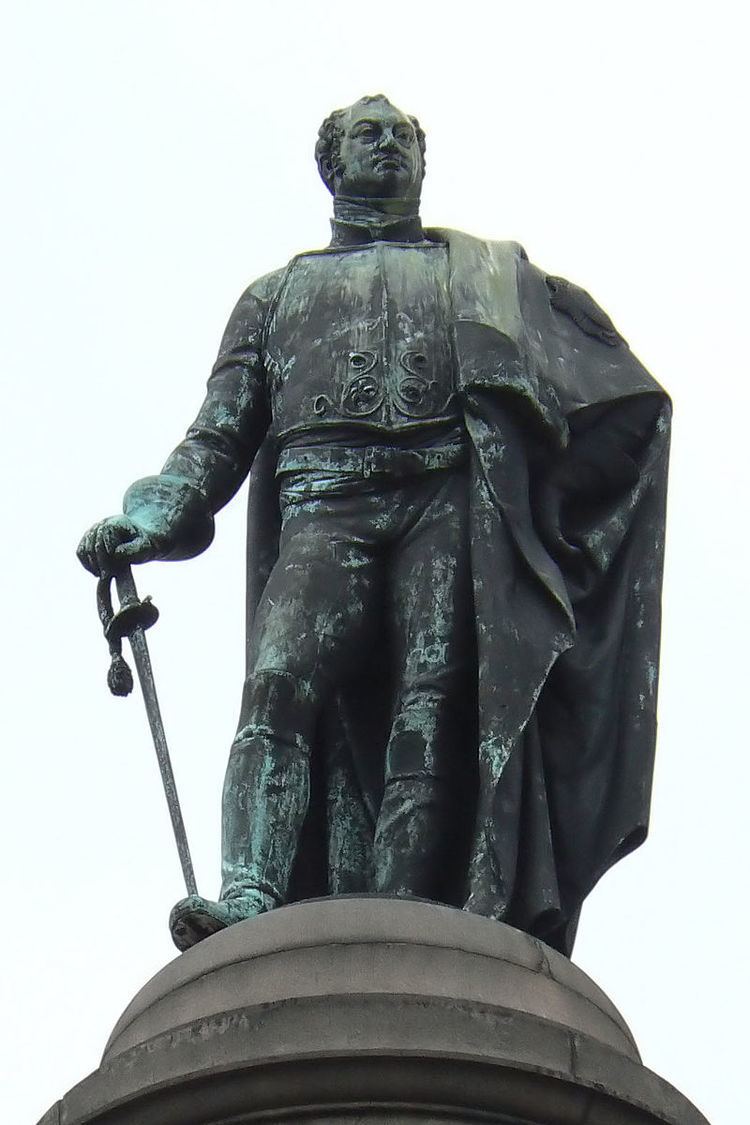Published 1642 | ||
 | ||
‘The Grand Old Duke of York’ (also sung as The Noble Duke of York) is an English children's nursery rhyme, often performed as an action song. The Duke of the title has been argued to be a number of the holders of that office, particularly Prince Frederick, Duke of York and Albany (1763–1827) and its lyrics have become proverbial for futile action. It has a Roud Folk Song Index number of 742.
Contents
Lyrics
The most common modern version is:
Actions
There may be almost as many slight or great variations to the actions as there are groups to regularly perform them and pass on their style, but the core movements are often based upon the performers standing whenever a clear "up" is sung, reseating themselves whenever "down" is mentioned and briefly taking an abbreviated half-standing/crouching position for the "only half-way up" phrase. A group of performers who, especially in an 'audience participation'-like situation, are originally seated (for example school children in an assembly, or the audience in a theatre - especially for a typical participative segment of a pantomime) will/should end the song back in their original positions.
The first verse is rather gentle one to react to, with one clear standing and one clear seating action, and so other actions may be given. For example: a stiff salute for the "Duke of York", indicating "ten" by clearly displaying ten fingers (optionally emphasising this on the further syllables of "thou-sand men") and/or forming the hands/arms into a some form depicting a 'hill' summit.
The second verse becomes far more rapid, especially between the two pairs of adjacent "up"s and "down"s (the performer may make a bob, between the two, to emphasise the separate positions, rather than just stay up/down), and synchronisation is easily lost by those who are not as quick or able to change positions, or who are new to the 'game' and not as practiced. This activity does help group-bonding in young children and encourages the following the teacher/leader of the activity, but its use is often more as an easily controlled game that promotes physical activity.
In an entertainment situation, however, performance errors may actually be the objective. After the first time through, the hosts may coerce the participants to repeat it several more times at ever faster tempos, with the deliberate aim of creating slightly breathless merriment by all concerned from the obvious and confused desynchronisation that emerges by the end of the final cycle. Other intentionally induced confusions might be to ask all those performing (or, perhaps in turns, only 'this half of the audience'/'that half of the audience', just the women/girls or just the gentlemen/boys) to switch the "up" and "down" actions for a round, to create a particularly chaotic spectacle as performers attempt to reverse their natural responses to the words, or not to instinctively echo the movements of those nearby who are doing it 'wrong'.
The standing and sitting and possible arm-waving (especially when not synchronised, by intent or otherwise) might be considered to be unsuitable for some situations and less expansive actions (simply reaching up, down, half-way up with an arm) might be substituted, to be less potentially injurious in cramped situations or amongst those less capable of movement, whilst more elaborate 'performance' versions might involve more dynamic posing (e.g. choreographed marching and linking of arms), especially if intended as a 'demonstration piece' such as by pupils on stage in a school concert whereupon perfection is the aim.
Origins
Like many popular nursery rhymes the origins of the song have been much debated and remain unclear. Unusually the rhyme clearly refers to a historical person and debates have tended to circulate around identifying which Duke is being referred to in the lyrics. The lyrics were not printed in their modern form until relatively recently, in Arthur Rackham's Mother Goose in 1913. Prior to that a number of alternatives have been found including a note that in Warwickshire in 1892 the song was sung of both the Duke of York and the King of France; from 1894 that it was sung of Napoleon. The oldest version of the song that survives is from 1642, under the title 'Old Tarlton's song', attributed to the stage clown Richard Tarlton (1530–1588) with the lyrics:
As a result, the argument has been made that it may have been a common satirical verse that was adapted as appropriate and, because it was recorded in roughly the modern form, has become fixed on the Duke of York.
Candidates for the duke in question include:
Apart from the ducal title in the song and the events of their lives there is no external evidence to link the rhyme to any of these candidates.
Song
"The Grand Old Duke of York" is also sung to the tune of "A-Hunting We Will Go".
Dutch version
A Dutch adaptation of the song replaces the Duke of York with Maurice, Prince of Orange (1567–1625), stadtholder of six of the seven provinces of the Dutch Republic, and its most important military commander after the death of his father William the Silent in 1584. Prince Maurice was able to reconquer large parts of the Habsburg Netherlands, adding them to territory of the emergent Republic, especially during its first Ten Years (1588–98). His practice of training mercenaries (completely new, and mocked at first) and subsequent military successes became famous throughout Europe. It is not known when the British song crossed the North Sea and was attributed to Maurice, but nowadays it's well-known within the Dutch scouting movement.
